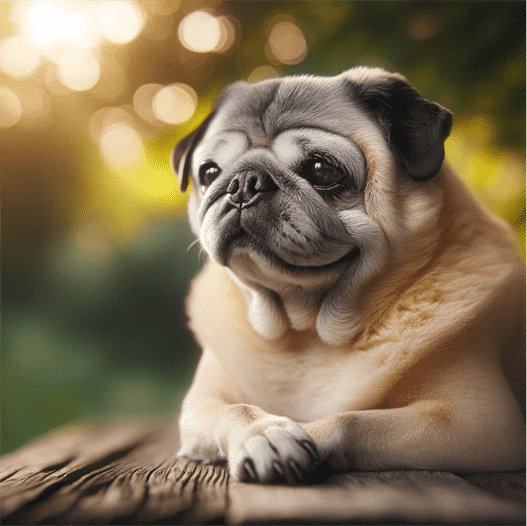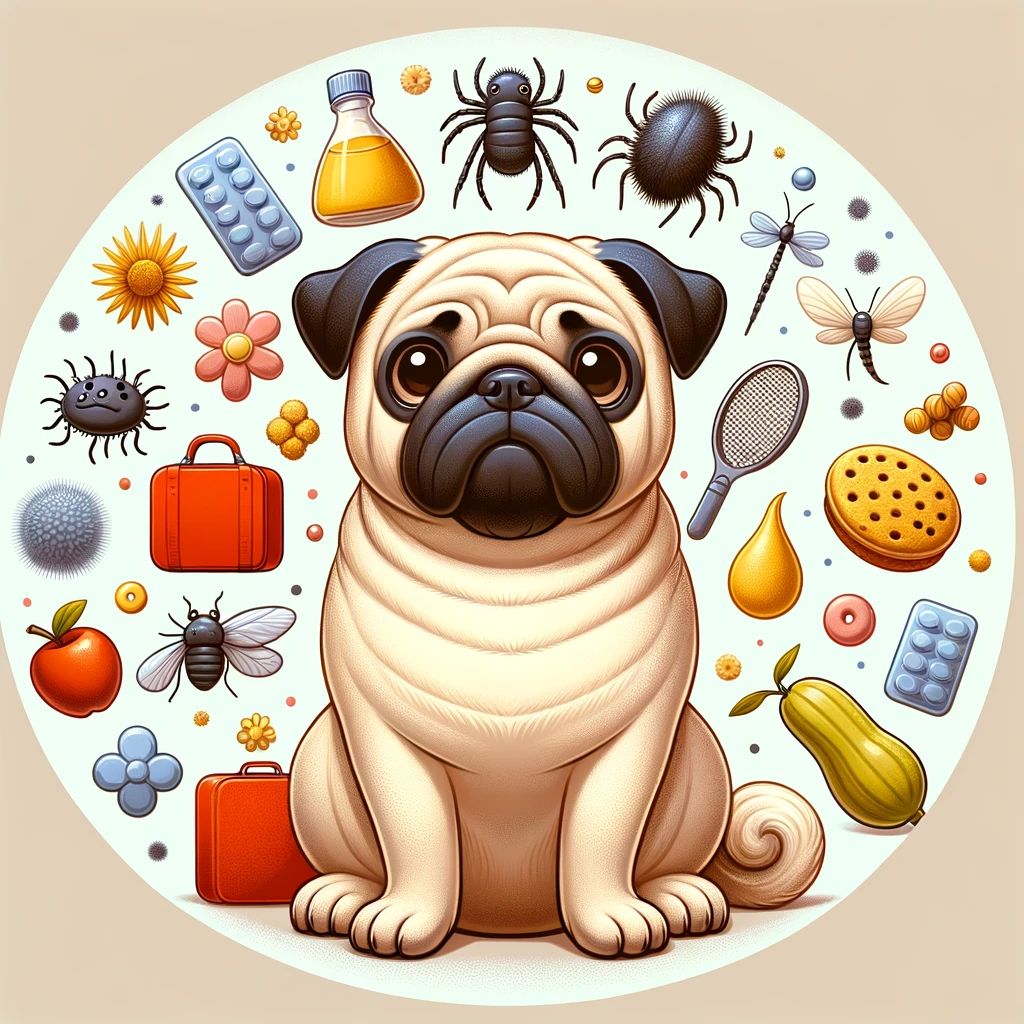Why Senior Pug Care Matters
As pugs enter their senior years, their health and wellness needs change dramatically. As they age, senior pug care becomes increasingly important. Senior pugs, generally classified as those over the age of seven, require special care to ensure they remain comfortable, healthy, and happy. Their small, compact bodies and predisposition to health issues mean that age-related concerns can quickly arise if not addressed proactively.
Why Senior Pug Care is Critical for Longevity
From mobility issues to breathing problems, dental health, and weight management, aging pugs face challenges that younger pugs might not. It’s crucial for pug owners to recognize these changes and adjust their senior pug care routine accordingly. With the right steps, senior pugs can enjoy their golden years, maintaining their quality of life while avoiding common health pitfalls associated with aging.
In this post, we’ll explore the key aspects of senior pug care, offering expert advice on everything from diet and exercise to preventive health measures and mental stimulation. By understanding the specific needs of your aging pug, you can ensure they stay active, engaged, and happy for as long as possible with specific sent pug care.
Recognizing the Signs of Aging in Pugs

As your pug grows older, it’s important to recognize the subtle signs of aging. Many of these changes happen gradually, so it’s easy to overlook them until they become more pronounced. Identifying these signs early allows you to adjust their senior pug care and catch potential health issues before they worsen.
Physical Aging Symptoms in Senior Pug Care
One of the most noticeable signs of aging in pugs is the graying of their fur, particularly around the muzzle and face. You might also observe a loss of muscle tone and weight fluctuations. Senior pugs tend to lose muscle mass over time, making them appear thinner or frailer than they were in their younger years.
Additionally, you may notice that your senior pug is slower to move, reluctant to jump or climb stairs, and generally more stiff or sore after periods of inactivity. These are common signs of joint pain or arthritis, which affects many aging pugs.
The Greying Process for Senior Pugs
One of the main aging signs in pugs is the graying of their fur, particularly around the muzzle and face. You might also observe a loss of muscle tone and weight fluctuations. Senior pugs tend to lose muscle mass over time, making them appear thinner or frailer than they were in their younger years.
Additionally, you may notice that your senior pug is slower to move, reluctant to jump or climb stairs, and generally more stiff or sore after periods of inactivity. These are common signs of joint pain or arthritis, which affects many aging pugs.
Behavioral Changes in Older Pugs
Older pugs often experience changes in behavior. Your once energetic pug might sleep more, exhibit less enthusiasm for playtime, or seem disinterested in activities they used to love. Cognitive decline, sometimes referred to as canine cognitive dysfunction (similar to dementia in humans), may also appear in senior pugs, causing confusion, disorientation, or forgetfulness.
Appetite and Thirst Adjustments for Aging Pugs
While some senior pugs may become less interested in food, others may overeat due to metabolic changes. You might also observe increased thirst, which can be a sign of kidney disease or diabetes. If your pug is drinking more than usual, it’s important to consult your vet. Regular monitoring is key as part of any senior pug care plan to put in place.
Tip: Keep an eye out for sudden changes in weight, appetite, or energy levels. These could be early indicators of an underlying health issue that needs attention.
"Pugs generally begin to show signs of aging between 7 and 10 years, with some developing gray hairs around their muzzle as early as 5. Research in Applied Animal Behaviour Science suggests a link between premature graying and stress, indicating that anxious or impulsive behaviors may accelerate visible aging in dogs. This underscores the importance of managing stress to help maintain their well-being as they age."
Addressing Common Health Issues in Senior Pugs
As pugs age, they become more vulnerable to certain health problems. Identifying these issues early and taking proactive measures can help improve their quality of life. Here’s a closer look at some common health concerns for senior pug care

Managing Arthritis in Senior Pug Care
One of the most frequent issues in senior pugs is arthritis. Over time, their joints experience wear and tear, leading to stiffness, discomfort, and difficulty moving. This condition is particularly prevalent in pugs due to their stocky frames, which put extra pressure on their joints.
Managing arthritis often involves providing joint supplements, such as glucosamine and chondroitin, and adjusting their exercise routine to low-impact activities that are easier on their joints.
Senior Pug Breathing Difficulties
Pugs are already prone to breathing problems due to their flat faces (brachycephalic features), and these issues can worsen with age. Senior pugs may develop more severe forms of brachycephalic obstructive airway syndrome (BOAS), resulting in labored breathing, loud snoring, or increased susceptibility to heat exhaustion.
Keeping your pug at a healthy weight and avoiding intense exercise, particularly in hot or humid weather, are essential for managing these breathing issues. Your vet may recommend additional treatments, including surgery, in severe cases.
Dental Health Solutions for Senior Pugs
Dental health can rapidly decline in senior pugs if left untreated. Plaque buildup, gum disease, and tooth decay are common problems that can lead to infections or tooth loss. Given the link between dental health and overall health (including heart and kidney issues), it’s important to maintain a dental care routine.
Regular at-home brushing, dental chews, and annual cleanings at the vet can help reduce the risk of severe dental disease.
Tackling Obesity in Older Pugs
Senior pugs often become less active, which can lead to weight gain. Unfortunately, obesity increases the likelihood of joint pain, heart disease, and breathing difficulties, creating a vicious cycle of health issues. Monitoring their food intake and ensuring they get appropriate exercise is critical to preventing obesity.
Eye Conditions and Vision Loss Management for Senior Pugs
Eye issues, including cataracts and dry eye, are common in older pugs. Cataracts cause cloudiness in the lens, leading to impaired vision, while dry eye (keratoconjunctivitis sicca) can cause irritation and inflammation of the eyes.
Routine eye exams and early treatment can help manage these conditions, potentially preventing vision loss.
Nutrition and Diet for Senior Pugs
A balanced diet is crucial for senior pugs to maintain a healthy weight and support their overall well-being. As your pug ages, their metabolism slows down, and their nutritional needs change. Here are some important factors to consider when adjusting their diet.
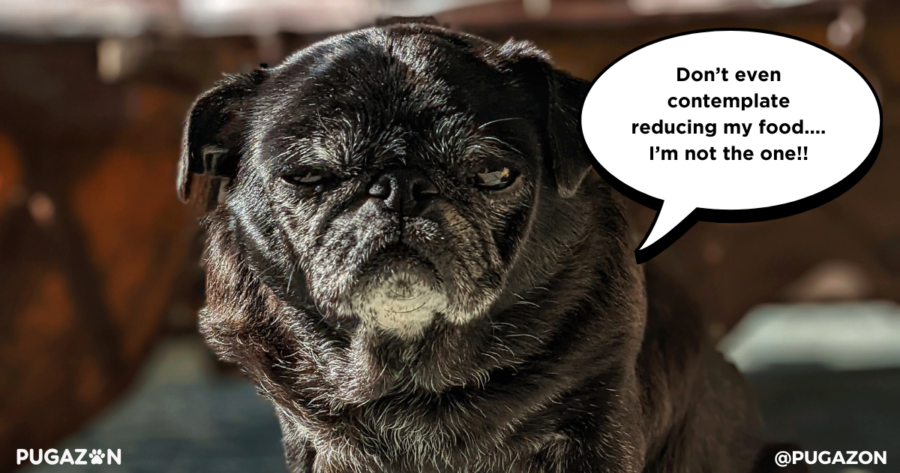
Low-Calorie Diets in Senior Pug Care
Senior pugs need fewer calories because they’re typically less active. It’s important to avoid overfeeding them, as excess weight can lead to a host of health problems, from joint pain to heart disease.
Switching to a senior-specific dog food is a great way to control their calorie intake. These formulas are designed to provide essential nutrients without the extra calories that come with regular adult dog food.
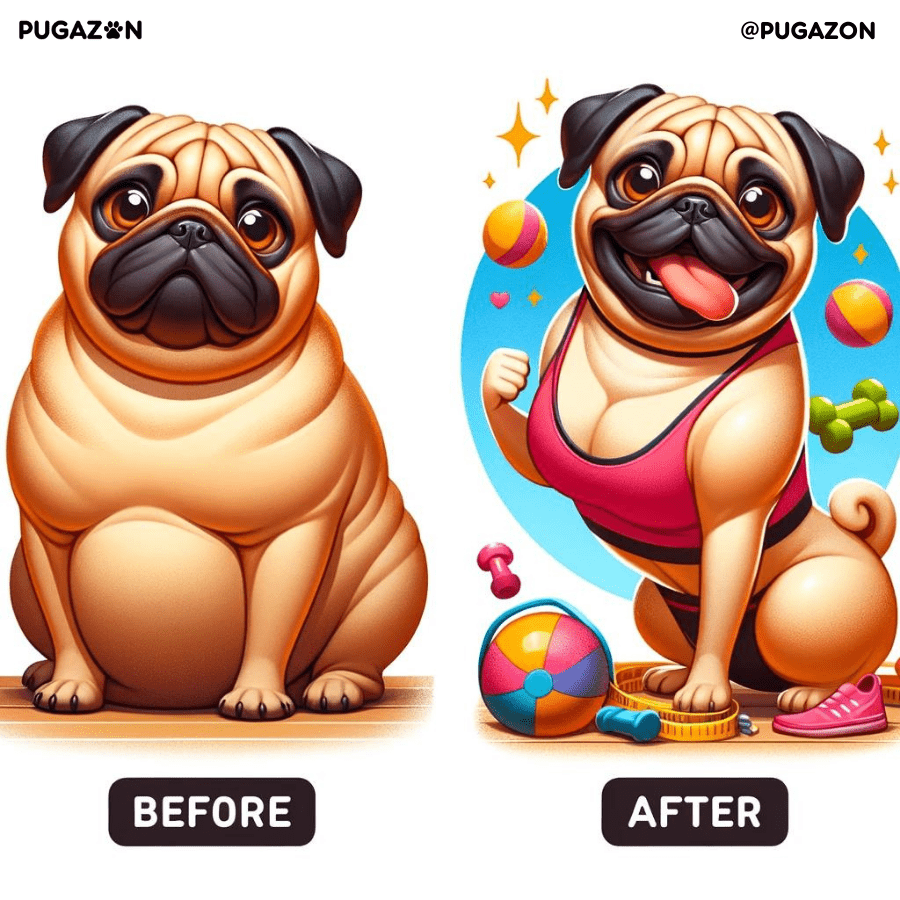
Last update on 2025-02-12 / * Affiliate links / Image source: Amazon Product Advertising API
Protein-Rich Foods for Muscle Health
Muscle mass tends to decrease with age, so it’s essential to choose food that contains high-quality protein to help maintain muscle. However, too much protein can strain aging kidneys, so it’s important to find a balance.
A senior dog food with moderate protein levels can help keep your pug strong without overtaxing their body.
Fiber and Digestive Support for Senior Pugs
Older pugs are prone to digestive issues, such as constipation or irregular bowel movements. A high-fiber diet can help regulate their digestive system and promote overall gut health. Many senior dog foods contain added fiber to support digestion, but you can also supplement their diet with fiber-rich foods like pumpkin or green beans.
Interesting Fact: Fiber can also help your senior pug feel fuller for longer, making it easier to manage their weight.
Joint Support for Senior Pugs
Adding joint supplements to your pug’s diet is essential as they age. Look for foods enriched with glucosamine and chondroitin, which help maintain cartilage and joint health. Omega-3 fatty acids, found in fish oils, can also reduce inflammation and support mobility.
If your pug is already on joint supplements, make sure they’re taking the appropriate dosage. Regular check-ins with your vet can help you monitor their joint health and make necessary adjustments to their diet.
Hydration Tips for Senior Pugs
complications like kidney disease. Wet food can be a helpful addition to your senior pug’s diet, as it provides extra moisture while being easier to chew than dry kibble.
Gentle Exercise for Aging Pugs

Maintaining physical activity is crucial for senior pugs, but their exercise routine needs to be adjusted to suit their changing needs. Here’s how to keep your pug moving without putting strain on their joints.
Low-Impact Exercises for Senior Pug Care
Senior pugs may no longer have the stamina for long walks, but short, frequent walks are still essential to keep them active. Aim for several 10-15 minute walks throughout the day rather than a single long outing. These walks help prevent stiffness and encourage mobility without overexerting your pug.
Did You Know Interactive toys aren’t just for young pups—senior pugs benefit from mentally stimulating activities that keep their brains sharp and prevent cognitive decline.
Benefits of Swimming for Joint Relief
Swimming is an excellent exercise for senior pugs as it provides a full-body workout without stressing their joints. The buoyancy of the water supports their weight, allowing them to move freely while burning calories and building muscle.
If you have access to a dog-friendly pool, swimming can be a great way to keep your pug active while minimizing the risk of injury.
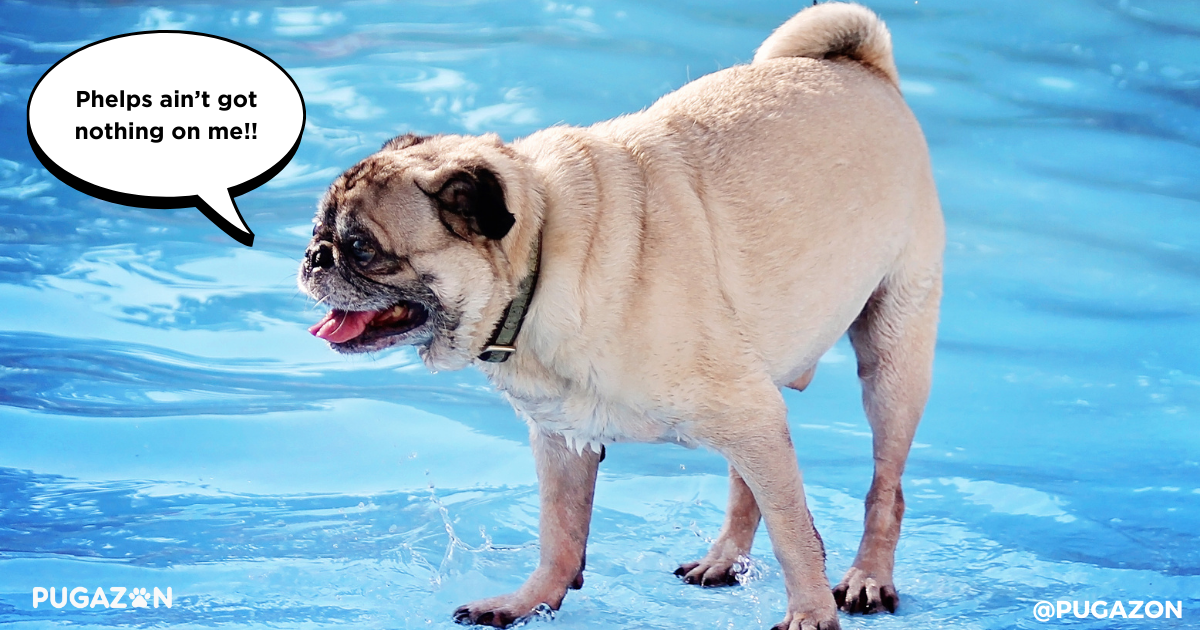
Puzzle Toys for Physical and Mental Engagement
When the weather isn’t ideal for outdoor walks, indoor games like gentle tug-of-war or using a ball can provide both mental and physical stimulation. Interactive puzzle toys that dispense treats encourage your pug to stay engaged and move around.
This type of low-impact activity is perfect for days when more strenuous exercise isn’t an option.
Monitor for Signs of Fatigue
Always keep an eye on your senior pug during exercise. Signs of fatigue or discomfort, such as excessive panting, limping, or stopping frequently, mean it’s time to rest. Overexertion can lead to injury, so be sure to tailor the exercise intensity based on your pug’s condition.
Preventive Health Care for Senior Pugs
Preventive care becomes increasingly important as your pug enters their senior years. Regular vet visits, diagnostic tests, and at-home care routines can significantly extend your pug’s life and improve their quality of life. Here’s how you can stay ahead of common health issues and ensure your senior pug receives the best care.
Always Stay Up to Date
Blood Tests and Diagnostics for Aging Pugs
While younger pugs may get by with annual vet visits, senior pugs should visit the vet at least twice a year. These checkups are crucial for catching early signs of illness and monitoring ongoing health conditions like arthritis, heart disease, or diabetes.
During these visits, your vet will likely perform a thorough physical examination, check your pug’s weight, and review any symptoms or behavior changes. They may also recommend routine blood work to check kidney and liver function, as well as thyroid levels.
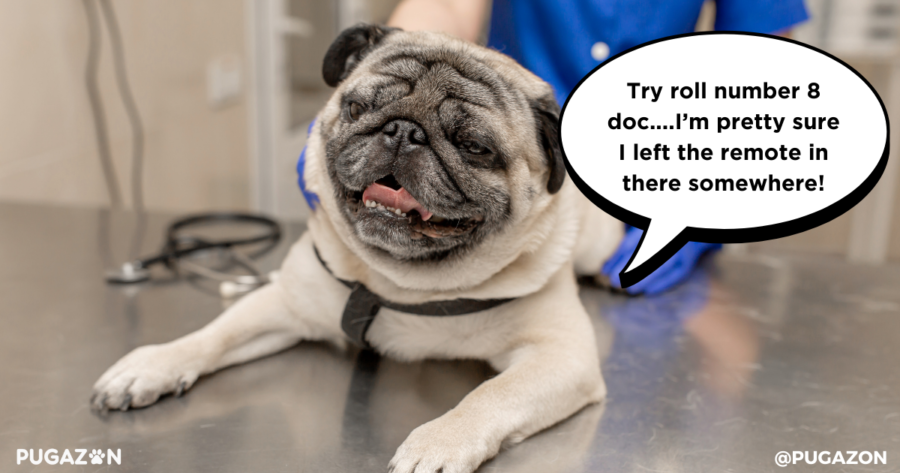
Blood Work and Diagnostics
Routine blood tests are essential for monitoring your senior pug’s internal health. As dogs age, their kidney and liver function may decline, which can lead to serious complications if not detected early. Blood work can also help identify underlying issues like anemia, diabetes, or thyroid imbalances.
Diagnostic Focus:
- Kidney and Liver Tests: These check for signs of organ deterioration, which is common in older dogs.
- Thyroid Panels: Help monitor thyroid function, ensuring your pug doesn’t suffer from conditions like hypothyroidism.
Dental Care Treatments with Older Pugs
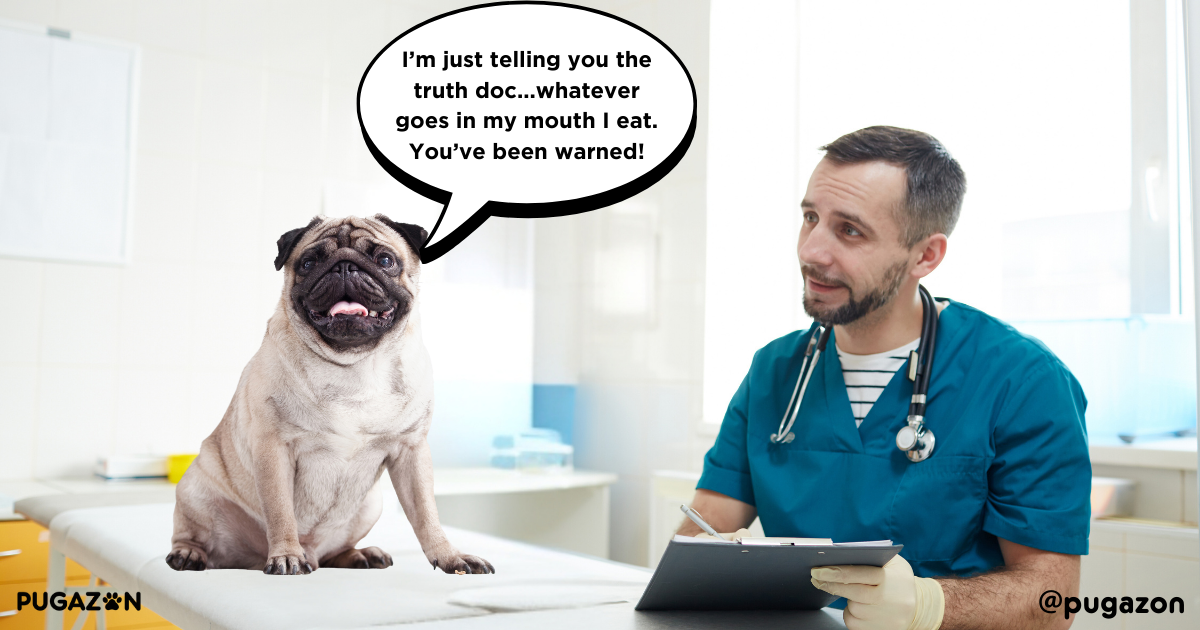
Dental health often declines in senior pugs, leading to tooth loss, gum disease, and even infections that can spread to other organs. Maintaining a good dental hygiene routine is crucial.
Regular brushing and dental chews can help keep plaque at bay, but professional cleanings are also recommended. Senior pugs may need annual dental cleanings under anesthesia to remove tartar and prevent more serious health issues down the road. Regular professional check ups when possible is advisable as part of a senior pug care routine.
Pro Tip: If your pug resists brushing, try introducing dental wipes or enzymatic gels as easier alternatives.
Vaccination Adjustments
While senior pugs still require vaccinations, your vet may recommend adjusting the schedule to avoid over-vaccinating. It’s important to ensure they remain protected from diseases while considering any potential side effects that could impact their aging bodies.
Ask your vet about titer tests, which can measure your dog’s immunity and determine if they still need booster vaccines.
Vision and Hearing Monitoring
Vision and hearing problems are common in senior pugs. Cataracts, dry eyes, and ear infections can all affect your pug’s sensory abilities, making it difficult for them to navigate their environment.
At-Home Monitoring:
- Eyes: Look for signs of cloudiness, redness, or discharge. These could indicate cataracts or infections.
- Ears: Watch for frequent head shaking or scratching, which might suggest an ear infection or hearing loss.
Routine eye and ear checkups at the vet, combined with at-home monitoring, will help manage these issues before they significantly impact your pug’s quality of life.
Weight Management for Older Pugs
Maintaining a healthy weight becomes more challenging for senior pugs due to their reduced activity levels and slower metabolism. However, managing your pug’s weight is critical for preventing additional health issues like joint pain, heart disease, and diabetes. Here’s how to keep your senior pug at an ideal weight.
Caloric Needs of Senior Pugs

As pugs age, their caloric needs decrease because they are less active and burn fewer calories. It’s essential to adjust their food portions accordingly to avoid unnecessary weight gain. A senior dog formula with lower calories but enriched with essential nutrients is usually the best option.
Instead of relying on general feeding guidelines, consult your vet for an accurate daily caloric recommendation based on your pug’s age, weight, and overall health. This personalized plan helps keep their weight in check.
Exercise for Weight Maintenance with Senior Pugs
While vigorous exercise may no longer be suitable for older pugs, keeping them active with low-impact activities is vital for maintaining a healthy weight. Multiple short walks and gentle playtime sessions throughout the day will help your pug burn calories and stay fit. Exercise not only helps with weight control but also keeps their joints and muscles in better shape and is crucial as part of any senior pug care routine.
Mental Stimulation for Senior Pugs
As your pug ages, keeping their mind sharp is just as important as maintaining their physical health. Mental stimulation helps prevent boredom and can slow cognitive decline, ensuring your pug remains engaged and happy well into their senior years. There are many ways to increase mental stimulation as part of senior pug care routines such as:
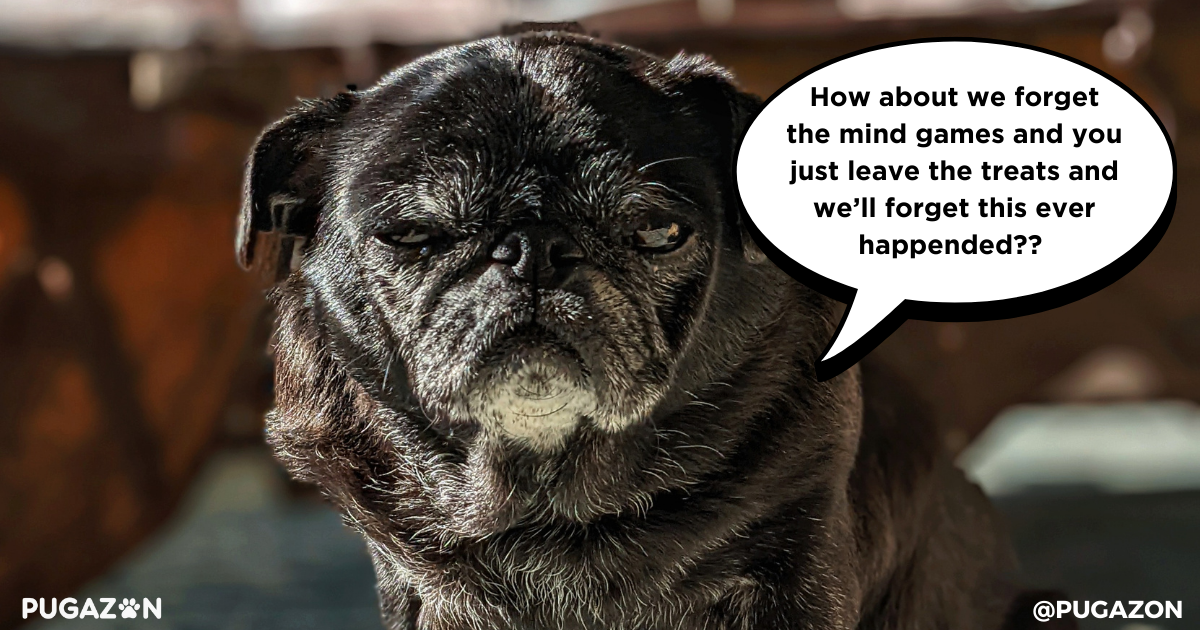
Toys to Stimulate Senior Pug Mental Health
Puzzle toys are a great way to challenge your senior pug’s brain. These toys require them to work for a treat, helping to keep their mind active and focused. Puzzle feeders, snuffle mats, and treat-dispensing toys are excellent options that combine mealtime with mental stimulation.
Consider rotating toys to keep things fresh and exciting. This variety helps prevent your pug from losing interest and adds a new level of challenge to their daily routine.
Social Interaction
Regular socialization with other calm dogs or even different family members can help keep your pug mentally stimulated. While senior pugs might not have the energy for long playdates, spending time with others offers social enrichment, keeps their brain engaged, and helps reduce feelings of isolation.
Incorporating new experiences into their routine—whether it’s meeting a new friend or exploring a new environment—adds an element of surprise and interest that can keep them mentally sharp.
Tailoring Your Pug’s Exercise Based on Health Conditions
As your pug ages, any health conditions they have must be factored into their exercise routine. Tailoring physical activity to their specific needs ensures they stay active without overexerting themselves.
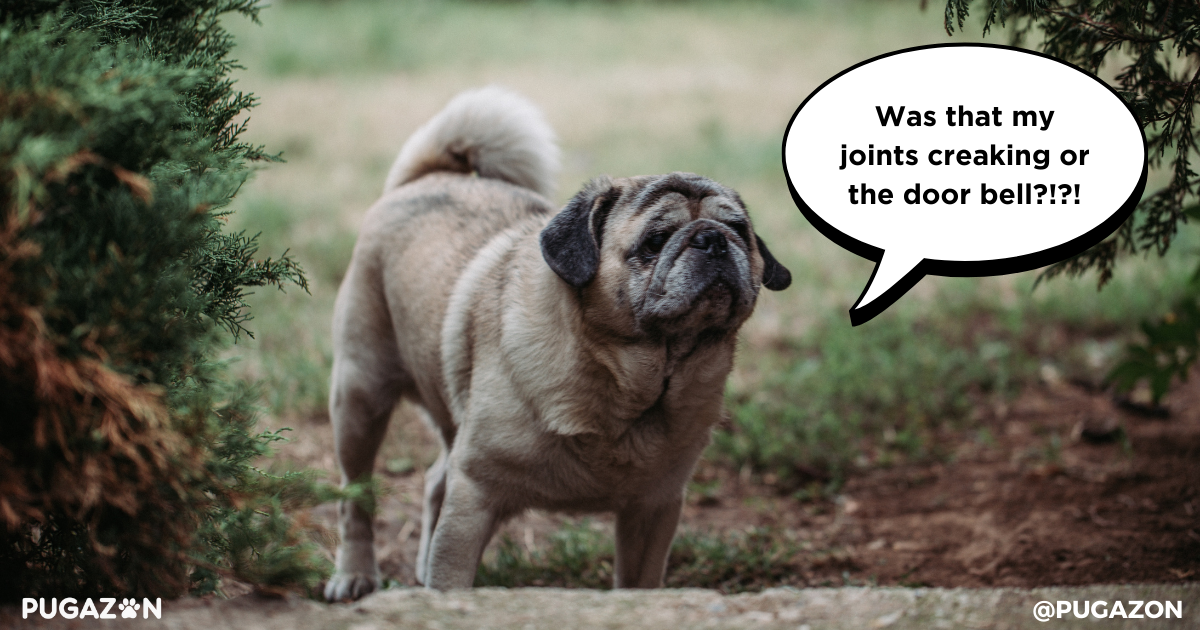
Pugs with Arthritis or Joint Pain
For pugs suffering from arthritis, it’s crucial to focus on low-impact exercises that don’t strain their joints. Walking on soft surfaces, such as grass or carpet, is gentler on their joints compared to hard surfaces like concrete. Swimming is another fantastic option, as it allows your pug to exercise without putting pressure on their legs and hips.
Pugs with Obesity
If your senior pug is overweight, exercise is an essential component of their weight loss plan. However, overweight pugs tire more easily and are prone to overheating, so it’s important to keep exercise sessions short and to monitor them closely for signs of fatigue.
Start with light activities, such as walking or slow-paced play, and gradually increase the duration and intensity as your pug builds stamina. Pairing this with a controlled diet ensures they lose weight safely and effectively.
Pugs with Breathing Issues
Senior pugs with brachycephalic obstructive airway syndrome (BOAS) require special consideration. These dogs may struggle with breathing during exercise, especially in hot or humid conditions. Limit outdoor activities during extreme weather and focus on gentle indoor exercises that keep your pug moving without taxing their respiratory system.
How to Make Your Home Senior Pug-Friendly
Creating a comfortable environment for your senior pug at home is essential to ensure they can move around safely and with ease. As they age, their mobility decreases, and their vision may deteriorate, making it harder to navigate stairs or slippery surfaces.
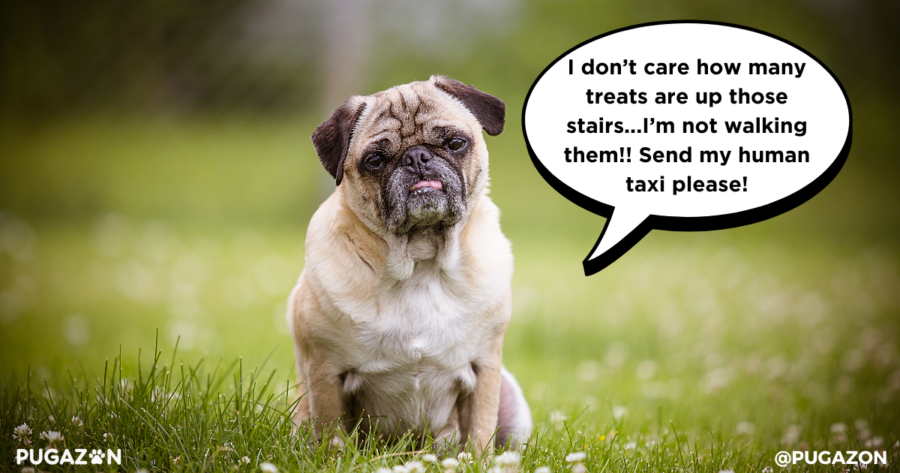
Ramps and Stairs
If your pug used to jump onto the couch or bed with ease, they may now struggle with these activities due to joint pain or limited mobility. Installing ramps or stairs next to their favorite spots allows them to get up and down without putting strain on their joints.
Additionally, ramps can be used for getting in and out of the car, making outings less of a hassle for both you and your pug.
Non-Slip Surfaces
Senior pugs may have difficulty walking on hardwood or tile floors, especially if they suffer from arthritis or mobility issues. Placing non-slip rugs or mats around your home, particularly in high-traffic areas, helps prevent slipping and ensures your pug can walk comfortably without risk of injury.
Orthopedic Beds
Long-Term Health Strategies for Senior Pug Care
Caring for a senior pug isn’t just about addressing immediate health concerns—it’s about developing long-term strategies to keep them healthy, active, and happy well into their golden years. With thoughtful planning and consistent care, you can significantly improve your pug’s overall well-being.
Balanced Diet and Nutrition
One of the most effective long-term strategies for maintaining your senior pug’s health is ensuring they receive a well-balanced diet. Adjusting their food to meet the needs of their slower metabolism and providing supplements for joint health, digestion, and coat quality will help them maintain their weight and vitality.
Switch to a senior dog formula designed to support healthy aging. These formulas are usually lower in calories but contain higher levels of joint-supporting nutrients like glucosamine and Omega-3 fatty acids.
Consistent, Gentle Exercise
Regular physical activity is essential for preventing obesity, keeping joints mobile, and boosting cardiovascular health. However, as your pug ages, exercise should be tailored to their energy levels and physical capabilities.
Focus on Consistency: It’s not about how intense the exercise is, but rather how regular it is. Short, daily walks and low-impact activities like swimming or gentle play help maintain muscle tone without overburdening their joints.
Mental Stimulation and Enrichment
Mental stimulation plays a key role in preventing cognitive decline in senior pugs. Incorporating mentally engaging activities like puzzle toys, training sessions, or even scent games can keep their minds sharp.
Creating a predictable routine while introducing small variations, like new toys or exploring different environments, helps keep them mentally alert without overwhelming them.
Regular Vet Visits and Health Monitoring

Senior pugs need regular vet checkups to monitor changes in their health, but you can also play an active role by conducting at-home checks between visits. Regularly inspect their ears, eyes, teeth, and skin for any signs of infection or discomfort.
In addition to physical exams, keeping an eye on their behavior, energy levels, and appetite can provide early warning signs of emerging health issues. Acting quickly when something feels off can make a significant difference in managing long-term health problems.
Joint and Mobility Support
As senior pugs are prone to arthritis and joint issues, long-term joint care is critical. You can support their mobility by using supplements like glucosamine, chondroitin, and Omega-3s, but environmental changes also help. Investing in orthopedic dog beds, ramps, and non-slip flooring can improve their quality of life.
Long-Term Management: Consistently providing joint supplements and adjusting their living environment to make mobility easier ensures your pug stays comfortable as they age.
Maintaining Social Interaction
As pugs age, they may become less interested in playing with other dogs or being as active socially. However, regular interaction with family members, other pets, or even other calm dogs can help keep them socially engaged, reducing anxiety or depression.
Balance Is Key: Provide opportunities for gentle socialization that don’t overwhelm your senior pug but keep them connected and happy.
FAQs About Senior Pug Care
A pug is generally considered a senior dog when they reach about seven years of age. However, every pug is different, and some may show signs of aging earlier or later. Look for changes in behavior, energy levels, and physical condition to gauge when your pug starts entering their golden years.
As pugs age, they become more susceptible to a variety of health issues, including:
- Arthritis and joint pain
- Breathing difficulties due to their flat faces (BOAS)
- Obesity from decreased activity
- Dental disease
- Eye problems like cataracts or dry eye
Regular vet checkups, a healthy diet, and gentle exercise can help manage these conditions effectively.
Maintaining a healthy weight is critical for your senior pug’s overall health. You can manage their weight by:
- Reducing their calorie intake with a senior-specific diet
- Providing smaller, more frequent meals
- Incorporating low-calorie treats, such as carrots or cucumbers
- Engaging in low-impact exercises like short walks or swimming
Senior pugs don’t require the same high-energy exercise as younger dogs, but regular, gentle activity is still essential to keep them fit and mobile. Short, slow walks (10-15 minutes) two to three times a day, along with indoor games or light play, help maintain muscle tone and prevent joint stiffness.
Yes, joint supplements such as glucosamine and chondroitin can help manage arthritis and improve mobility in senior pugs. Omega-3 fatty acids are also beneficial for reducing inflammation in their joints. Consult your vet about incorporating these into your pug’s daily routine.
Senior pugs should visit the vet at least twice a year for checkups. These visits allow your vet to monitor your pug’s health, track any changes, and catch potential problems like kidney or liver disease early. Routine blood tests, dental exams, and physical evaluations are essential for senior pugs.
Senior pugs benefit from a diet that is lower in calories but rich in nutrients that support joint health, digestive health, and overall vitality. Look for senior dog foods that contain:
- Moderate protein
- High fiber for digestion
- Joint support supplements like glucosamine
- Omega-3 fatty acids
Also, avoid human foods that are high in fat, sugar, and salt, as they can quickly lead to obesity and other health issues.
Absolutely! Dental health is vital for senior pugs, as neglected dental issues can lead to infections that affect their overall health. Regular brushing, dental chews, and professional cleanings are essential to prevent plaque buildup, gum disease, and tooth loss.
Mental stimulation is key to preventing cognitive decline in senior pugs. Activities like puzzle toys, scent games, and short training sessions help keep their brains sharp. Regular socialization, even if it’s just gentle interaction with family members, also keeps their minds active.
Senior pugs may not always show obvious signs of pain, but here are some subtle indicators:
- Limping or stiffness, especially after resting
- Reluctance to jump, climb stairs, or go for walks
- Whimpering or restlessness, especially at night
- Changes in appetite or behavior
If you notice any of these signs, consult your vet for pain management options, such as medication or joint supplements.


